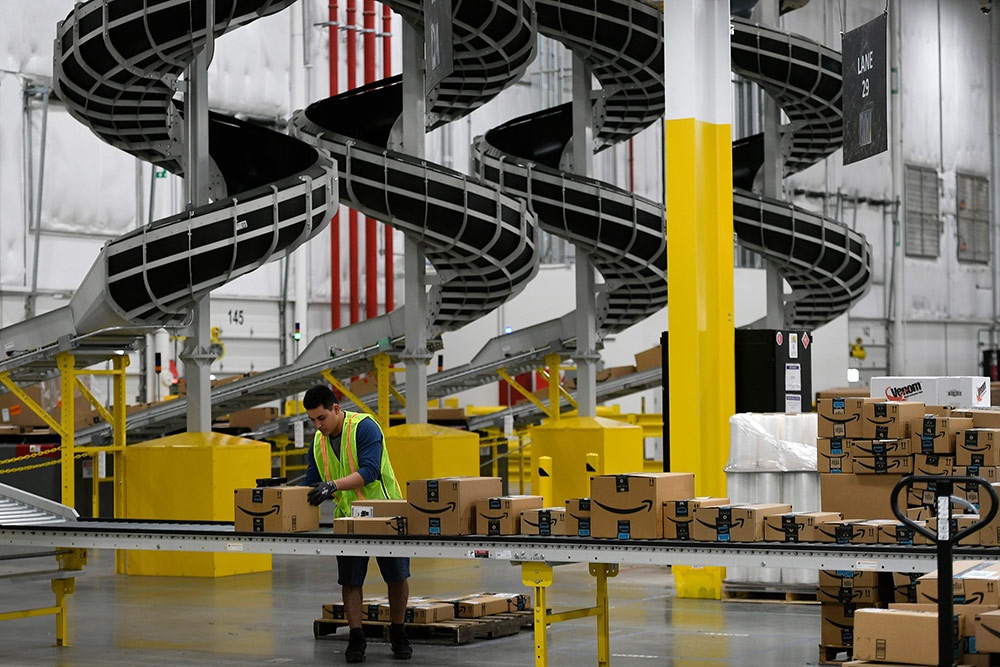
地方政府采用稅收減免政策吸引亞馬遜開設物流中心,,然而,,這家公司正在蠶食當?shù)氐慕?jīng)濟。
新冠疫情讓人們開始以新的視角來審視亞馬遜對待其倉庫員工的方式,,這份工作不僅勞動強度大,、極不穩(wěn)定,如今還面臨著接觸致命病毒的高風險,。然而,,亞馬遜在擴張其網(wǎng)絡方面可謂是勢不可擋,公司在全美各地百依百順的城市和州的幫助下開設了新設施,,但這些城市和州很少意識到亞馬遜對當?shù)亟?jīng)濟的毀滅性影響,。
例如在馬薩諸塞州北安多佛市,亞馬遜最近收到了2700萬美元的公共資金,,用于興建一個新倉庫,。在康涅狄格州溫索爾市,公司獲得了880萬美元的資金,。亞馬遜俄亥俄州格蘭威路市新配送中心的不動產(chǎn)稅獲得了15年減半征收的待遇,。這家電子商務巨頭在印第安納州懷特蘭德和伊利諾伊州阿靈頓高地的配送中心亦拿到了納稅人稅金??偟膩碚f,,亞馬遜收到了來自于州和地方政府近30億美元的補貼。這其中必然還存在其他類目的資助金,。
官員們認為這些貨幣激勵是必要的,,因為此舉能夠為當?shù)貛砉ぷ骱屯顿Y。然而事實上,,美國各地的決策者們正在花錢推動實體店的凋零,,并進一步確立亞馬遜作為經(jīng)濟各個門類守門人的角色。聯(lián)邦和州官員正在重新審視亞馬遜的影響力,,其中最顯著的事件就是7月底參議院召開的科技巨頭聽證會以及全國性的反壟斷調查,。地方政府官員亦需要注意亞馬遜的影響力。
亞馬遜的配送網(wǎng)絡至少有助于提振其兩個最大的利益:獲取客戶,,以及利用這一渠道迫使其他賣家達成推廣亞馬遜其他業(yè)務線的強制性安排,。Good Jobs First曾發(fā)現(xiàn),亞馬遜會戰(zhàn)略性地在可支配收入,、亞馬遜Prime會員以及前往高速和機場的交通干道較為集中的地區(qū)開設倉庫,。這一現(xiàn)象實屬情理之中,,因為亞馬遜的目標就是為那些可能購買其產(chǎn)品的人快速送貨,這一點與稅收減免或其他監(jiān)管優(yōu)惠政策無關,。
但亞馬遜還利用其倉庫,,向花錢聘請亞馬遜通過亞馬遜物流中心(FBA)處理其倉儲和配送的賣家提供Prime資質以及令人垂涎的“Buy Box”,并借此從其他企業(yè)那里獲取資金,。由于買家購買Prime服務適用產(chǎn)品的可能性要高得多,,因此亞馬遜可以強迫企業(yè)向亞馬遜付錢來承擔其倉儲業(yè)務,哪怕使用替代方法會更便宜,、更快,。
如果不使用亞馬遜的物流系統(tǒng),很多客戶基本上永遠也看不到你的產(chǎn)品,。在上個月的參議院聽證會上,,亞馬遜首席執(zhí)行官杰夫·貝佐斯也承認采用過這一手段。
這類安排還能夠讓亞馬遜繼續(xù)提振其送貨業(yè)務,。去年,,亞馬遜50%的包裹都是由自己配送,這個數(shù)字在2017年還不到15%,。亞馬遜使用了自身在某一個商業(yè)領域(例如線上購物)的統(tǒng)治地位來侵蝕其他行業(yè),,其最終的目標便是超過聯(lián)邦快遞和UPS。
亞馬遜迫使賣家使用其物流系統(tǒng),,即便此舉會放緩其送貨速度時亦是如此,。地方自力更生研究所的隆·諾克斯和肖烏爾·薩斯曼最近解釋稱,亞馬遜本可以在疫情期間訂單激增時重啟其關閉的Seller Fulfilled Prime(這種服務可以讓自發(fā)貨賣家有機會接觸并將產(chǎn)品銷售給亞馬遜Prime會員——譯者注)項目,,從而向負責自身物流的賣家提供Prime資質,。然而亞馬遜并沒有這么做,而后續(xù)的積壓訂單也讓關鍵訂單難以迅速到達其目的地,。
對于亞馬遜來說,,更重要的一點在于將訂單源源不斷地輸送至自家的儲存和配送系統(tǒng)中。使用亞馬遜物流中心的大多數(shù)公司都認為亞馬遜在這項業(yè)務中很快將處于壟斷地位,。
盡管如此,,很多地方政府官員依然對亞馬遜擴張補貼一事樂此不疲,因為他們認為此舉能給舉步維艱的城市和城鎮(zhèn)帶來工作和收入,,尤其是在疫情期間,,當?shù)仄髽I(yè)和政府預算因疫情遭到了毀滅性打擊。然而,,經(jīng)濟政策研究所稱,,新倉儲設施并沒有給當?shù)亟?jīng)濟帶來更多的就業(yè)增長。此舉要么會阻礙其他經(jīng)濟活動,要么對當?shù)亟?jīng)濟的整體貢獻不值一提,。
亞馬遜還削弱了傳統(tǒng)零售業(yè),,繼而影響了地方財政收入,。2015年的一篇分析發(fā)現(xiàn),,亞馬遜銷售業(yè)績所取代的零售店面原本可以貢獻5.28億美元的不動產(chǎn)稅。這還沒有計算亞馬遜獲得的專項稅收優(yōu)惠,,通常以不動產(chǎn)稅減免的形式,。
通過持續(xù)資助亞馬遜物流網(wǎng)絡的擴張,各大城市和州正在一步步讓當?shù)氐膶嶓w店陷入越來越落后的境地,,而且也讓亞馬遜的壟斷地位從在線購物延伸至物流,、配送等領域,也就進一步扼殺了其競爭對手在這些地區(qū)出現(xiàn)的可能性,。由于亞馬遜得到了這些城市和州的保駕護航,,當?shù)叵M麛U張的企業(yè)將不得不通過付費的方式來接觸亞馬遜的客戶群,而且這一費用要高于亞馬遜一貫的平臺使用費,。
有鑒于配送網(wǎng)絡是亞馬遜的必要組件,,因此即便沒有納稅人的資助,公司也非常愿意設立新設施,,例如它在康尼狄格州丹布利,、德州福德本德郡新開設的設施。地方官員必須收緊錢袋,,將其有限的資源用于提供關鍵服務,,并扶持當?shù)厥苄鹿谝咔閲乐赜绊懙男∑髽I(yè),而不是將其用來補貼亞馬遜,。(財富中文網(wǎng))
帕特·加羅法洛是美國經(jīng)濟自由項目國家與地方政策業(yè)務主任,,也是《億萬美元的無效投資:政客是如何讓企業(yè)和權貴偷走我們的資金和工作》一書的作者。
作者:Pat Garofale
譯者:Feb
地方政府采用稅收減免政策吸引亞馬遜開設物流中心,,然而,,這家公司正在蠶食當?shù)氐慕?jīng)濟。
新冠疫情讓人們開始以新的視角來審視亞馬遜對待其倉庫員工的方式,,這份工作不僅勞動強度大,、極不穩(wěn)定,如今還面臨著接觸致命病毒的高風險,。然而,,亞馬遜在擴張其網(wǎng)絡方面可謂是勢不可擋,公司在全美各地百依百順的城市和州的幫助下開設了新設施,,但這些城市和州很少意識到亞馬遜對當?shù)亟?jīng)濟的毀滅性影響,。
例如在馬薩諸塞州北安多佛市,亞馬遜最近收到了2700萬美元的公共資金,用于興建一個新倉庫,。在康涅狄格州溫索爾市,,公司獲得了880萬美元的資金。亞馬遜俄亥俄州格蘭威路市新配送中心的不動產(chǎn)稅獲得了15年減半征收的待遇,。這家電子商務巨頭在印第安納州懷特蘭德和伊利諾伊州阿靈頓高地的配送中心亦拿到了納稅人稅金,。總的來說,,亞馬遜收到了來自于州和地方政府近30億美元的補貼,。這其中必然還存在其他類目的資助金。
官員們認為這些貨幣激勵是必要的,,因為此舉能夠為當?shù)貛砉ぷ骱屯顿Y,。然而事實上,美國各地的決策者們正在花錢推動實體店的凋零,,并進一步確立亞馬遜作為經(jīng)濟各個門類守門人的角色,。聯(lián)邦和州官員正在重新審視亞馬遜的影響力,其中最顯著的事件就是7月底參議院召開的科技巨頭聽證會以及全國性的反壟斷調查,。地方政府官員亦需要注意亞馬遜的影響力,。
亞馬遜的配送網(wǎng)絡至少有助于提振其兩個最大的利益:獲取客戶,以及利用這一渠道迫使其他賣家達成推廣亞馬遜其他業(yè)務線的強制性安排,。Good Jobs First曾發(fā)現(xiàn),,亞馬遜會戰(zhàn)略性地在可支配收入、亞馬遜Prime會員以及前往高速和機場的交通干道較為集中的地區(qū)開設倉庫,。這一現(xiàn)象實屬情理之中,,因為亞馬遜的目標就是為那些可能購買其產(chǎn)品的人快速送貨,這一點與稅收減免或其他監(jiān)管優(yōu)惠政策無關,。
但亞馬遜還利用其倉庫,,向花錢聘請亞馬遜通過亞馬遜物流中心(FBA)處理其倉儲和配送的賣家提供Prime資質以及令人垂涎的“Buy Box”,并借此從其他企業(yè)那里獲取資金,。由于買家購買Prime服務適用產(chǎn)品的可能性要高得多,,因此亞馬遜可以強迫企業(yè)向亞馬遜付錢來承擔其倉儲業(yè)務,哪怕使用替代方法會更便宜,、更快,。
如果不使用亞馬遜的物流系統(tǒng),很多客戶基本上永遠也看不到你的產(chǎn)品,。在上個月的參議院聽證會上,,亞馬遜首席執(zhí)行官杰夫·貝佐斯也承認采用過這一手段。
這類安排還能夠讓亞馬遜繼續(xù)提振其送貨業(yè)務,。去年,,亞馬遜50%的包裹都是由自己配送,,這個數(shù)字在2017年還不到15%。亞馬遜使用了自身在某一個商業(yè)領域(例如線上購物)的統(tǒng)治地位來侵蝕其他行業(yè),,其最終的目標便是超過聯(lián)邦快遞和UPS,。
亞馬遜迫使賣家使用其物流系統(tǒng),即便此舉會放緩其送貨速度時亦是如此,。地方自力更生研究所的隆·諾克斯和肖烏爾·薩斯曼最近解釋稱,,亞馬遜本可以在疫情期間訂單激增時重啟其關閉的Seller Fulfilled Prime(這種服務可以讓自發(fā)貨賣家有機會接觸并將產(chǎn)品銷售給亞馬遜Prime會員——譯者注)項目,從而向負責自身物流的賣家提供Prime資質,。然而亞馬遜并沒有這么做,,而后續(xù)的積壓訂單也讓關鍵訂單難以迅速到達其目的地,。
對于亞馬遜來說,,更重要的一點在于將訂單源源不斷地輸送至自家的儲存和配送系統(tǒng)中。使用亞馬遜物流中心的大多數(shù)公司都認為亞馬遜在這項業(yè)務中很快將處于壟斷地位,。
盡管如此,,很多地方政府官員依然對亞馬遜擴張補貼一事樂此不疲,因為他們認為此舉能給舉步維艱的城市和城鎮(zhèn)帶來工作和收入,,尤其是在疫情期間,,當?shù)仄髽I(yè)和政府預算因疫情遭到了毀滅性打擊。然而,,經(jīng)濟政策研究所稱,,新倉儲設施并沒有給當?shù)亟?jīng)濟帶來更多的就業(yè)增長。此舉要么會阻礙其他經(jīng)濟活動,,要么對當?shù)亟?jīng)濟的整體貢獻不值一提,。
亞馬遜還削弱了傳統(tǒng)零售業(yè),繼而影響了地方財政收入,。2015年的一篇分析發(fā)現(xiàn),,亞馬遜銷售業(yè)績所取代的零售店面原本可以貢獻5.28億美元的不動產(chǎn)稅。這還沒有計算亞馬遜獲得的專項稅收優(yōu)惠,,通常以不動產(chǎn)稅減免的形式,。
通過持續(xù)資助亞馬遜物流網(wǎng)絡的擴張,各大城市和州正在一步步讓當?shù)氐膶嶓w店陷入越來越落后的境地,,而且也讓亞馬遜的壟斷地位從在線購物延伸至物流,、配送等領域,也就進一步扼殺了其競爭對手在這些地區(qū)出現(xiàn)的可能性,。由于亞馬遜得到了這些城市和州的保駕護航,,當?shù)叵M麛U張的企業(yè)將不得不通過付費的方式來接觸亞馬遜的客戶群,而且這一費用要高于亞馬遜一貫的平臺使用費,。
有鑒于配送網(wǎng)絡是亞馬遜的必要組件,,因此即便沒有納稅人的資助,,公司也非常愿意設立新設施,例如它在康尼狄格州丹布利,、德州福德本德郡新開設的設施,。地方官員必須收緊錢袋,將其有限的資源用于提供關鍵服務,,并扶持當?shù)厥苄鹿谝咔閲乐赜绊懙男∑髽I(yè),,而不是將其用來補貼亞馬遜。(財富中文網(wǎng))
帕特·加羅法洛是美國經(jīng)濟自由項目國家與地方政策業(yè)務主任,,也是《億萬美元的無效投資:政客是如何讓企業(yè)和權貴偷走我們的資金和工作》一書的作者,。
作者:Pat Garofale
譯者:Feb
The coronavirus pandemic has brought new scrutiny to the way in which Amazon treats its warehouse workers, whose exhausting, precarious positions now come with a decent chance they’ll be exposed to a deadly virus. And yet, Amazon is going gangbusters to expand its network, opening new facilities all across the country with the aid of compliant cities and states and little recognition of Amazon’s devastating impact on local economies.
In North Andover, Mass., for instance, Amazon recently received $27 million in public funding to build a new warehouse. In Windsor, Conn., it was $8.8 million. The property taxes for a new Amazon distribution center in Glenwillow, Ohio, will be reduced by nearly half for 15 years. And the e-commerce giant is receiving taxpayer dollars for distribution facilities in Whiteland, Ind., and Arlington Heights, Ill., too. Overall, Amazon has received nearly $3 billion in subsidies from state and local governments. There are surely other handouts in the works.
Officials justify these monetary favors as necessary for bringing jobs and investment to a local area. But in truth, policymakers are funding the demise of Main Streets across America and further entrenching Amazon as a gatekeeper across wide swathes of the economy. Federal and state officials are looking anew at Amazon’s power, most prominently through Congress’ big tech hearing in late July and state-level antitrust investigations. Local officials need to pay attention to Amazon’s power, too.
Amazon’s distribution network promotes at least two significant interests for the company: accessing customers and using that access to force other sellers into coercive arrangements that promote Amazon’s other lines of business. As Good Jobs First has found, Amazon strategically places warehouses where there is a concentration of disposable income, Amazon Prime subscribers, and easy access to highways and airports. That makes sense, since Amazon’s aim is to get stuff to people who are likely to buy things from it faster, regardless of any sort of tax incentive or other regulatory favor.
But Amazon also leverages its warehouses to extract funds from other businesses by giving Prime Eligibility and the coveted “Buy Box” to sellers who pay Amazon to handle their storage and distribution through Fulfillment by Amazon, or FBA. Because buyers are far more likely to buy items that are Prime eligible, Amazon can coerce businesses into paying Amazon to handle their warehousing, even if it would be cheaper and faster to use alternative methods.
Don’t use Amazon’s fulfillment system, and loads of customers simply never see your product. During last month’s congressional hearing, Amazon CEO Jeff Bezos admitted to employing this tactic.
This sort of arrangement also allows the company to continue to bolster its shipping operation. Last year, Amazon delivered nearly 50% of its own packages, compared to less than 15% in 2017. Dominance in one area of commerce—online shopping—is being used by Amazon to make inroads into others, with the eventual aim of toppling FedEx and UPS.
Amazon pushes sellers into using its logistics system even when doing so slows down deliveries. As Ron Knox and Shaoul Sussman of the Institute for Local Self-Reliance recently explained, Amazon could have reopened its shuttered Seller Fulfilled Prime program when orders spiked during the pandemic, granting Prime eligibility to sellers who handle their own logistics. It didn’t, and the subsequent backlog kept critical orders from reaching their destination quickly.
To Amazon, it was simply more important to keep funneling orders into its own storage and delivery system. Most companies in the fulfillment space think Amazon is well on its way to monopolizing the business.
Despite all this, many local officials are still keen on subsidizing Amazon’s expansion because they believe it will bring jobs and revenue to struggling cities and towns, especially during a pandemic that has devastated local businesses and government budgets. But according to the Economic Policy Institute, new warehouses don’t bring wider employment growth to a local economy. They either blunt other economic activity or have too small of an overall impact to even measure.
Amazon also decimates local budgets through its effect on traditional retail. A 2015 analysis found that Amazon sales displaced retail outlets that would have paid $528 million in property taxes. And that’s before getting into the specific tax benefits given to Amazon, which usually come in the form of property tax reductions.
By continually funding the expansion of Amazon’s fulfillment network, cities and states are ensuring that their own brick-and-mortar stores fall ever further behind, and that Amazon’s monopoly power extends from online shopping to logistics, shipping, and beyond, making the emergence of a competitor in any of those areas ever more unlikely. They’re guaranteeing that local businesses hoping to expand will be forced to pay tolls to access Amazon’s customer base, above and beyond the usual fees Amazon extracts from users of its platform.
Since Amazon needs its distribution network, it is perfectly willing to open new facilities without taxpayer largesse—as it reportedly did in Danbury, Conn., and Fort Bend County, Texas. Rather than subsidizing Amazon, local officials must close the spigot, and focus their limited resources on providing key services and promoting small, local businesses that are threatened by the COVID-19 pandemic.
Pat Garofalo is director of state and local policy at the American Economic Liberties Project and author of The Billionaire Boondoggle: How Our Politicians Let Corporations and Bigwigs Steal Our Money and Jobs.






